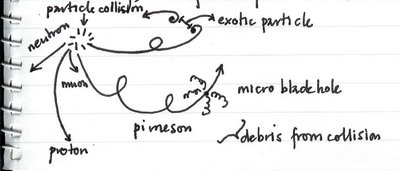 How jet skis can be used to explain Special Relativity
How jet skis can be used to explain Special RelativityImagine a jet skier travelling north at 100km/h, and another one travelling east at 100km/h, and draw a graph of their paths over a period of time (such as a second). Now imagine another jet skier travelling north-east and draw his (we will assume it's a male) path on the graph: the plots of all three are the same length but if you read the graph back to the axes, the third jet skier is not travelling at 100km/h, but appears to be going slightly slower than the two that are travelling along the axes. Now change north to Time and East to Space and there you have special relativity: the faster you travel through space, the slower you travel through time.
Why the universe is easier to understand the more complicated it gets
Joss Hawthorn is very excited about the Large Hadron Collider at CERN, which Dr Brian Cox talked about in the Science Week lecture that the Dude and I attended. The problem with dark matter is that it is dark (duh!), not just to our eyes, but across the entire electromagnetic spectrum: it just doesn't show up on any detector we've been able to build so far because it doesn't interact with baryons (the stuff that stars -- and people -- are made of). So how do we know that dark matter is there? Because we need it to be there, to explain why the universe is shaped the way it is.
One theory about why we can't see it is because it exists in one of the seven other dimensions that are predicted by string theory. So the great minds of our time are busy trying to work out how to see into those other dimensions: Joss Hawthorn reverently refers to the work of Ed Witten, who he claims is the greatest thinker since Einstein, and Stephen Hawking should eat his heart out.
This is why they are building the Large Hadron Collider, where -- when they turn it on in 2008 -- they will smash gold atoms together and make pretty pictures of the results. Here's my drawing of the picture Joss drew on the blackboard of what the results might look like:

So that's all clear then? Good.
Oh. Well, just in case, here is a link to the Millenium Simulation at the Max Planck Institute, showing what the universe would look like if you could see the dark matter. Very pretty.
Stay tuned for next week's lecture on wide-field astronomy.

No comments:
Post a Comment